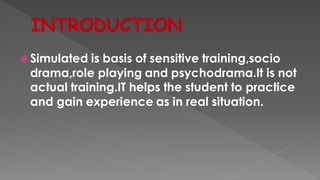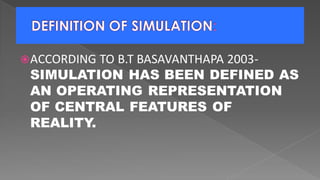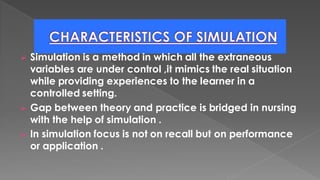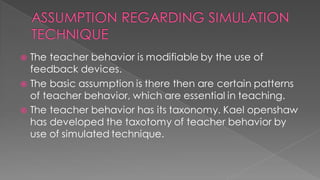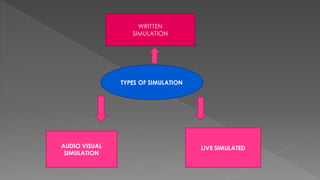Simulation
- 1. SUBMITTED TO-: MRS. LEHALI BALA CLINICAL INSTRUCTOR AND TUTOR COLLEGE OF NURSING RIMS,RANCHI SUBMITTED BY-: NIKHAT PARWEEN ROLL NO.-13 SHAINY BHADRA ROLL NO.-34 COLLEGE OF NURSING ,RIMS
- 2. OBJECTIVE INTRODUCTION DEFINITION PURPOSE CHARACTERISTICS ACTIVITIES STEPS OF SIMULATION TYPES OF SIMULATION ADVANTAGE DISADVANTAGE REFERENCES BIBLIOGRAPHY
- 3. 1) Present a simplified abstraction of the essential elements of a situation. 2) Move the time variable ahead at an accelerated speed so that the implications arising from action taken in a dynamic situation may be clearly experienced; 3)Make explicit the essential relations and fundamental interactions in a situation; 4) Place the participant in a pressure situation, so that he feels the direct impact of decision-making; 5) Offer an opportunity to participate in the teaching-learning process based on a self-teaching approach.
- 4. Simulated is basis of sensitive training,socio drama,role playing and psychodrama.It is not actual training.IT helps the student to practice and gain experience as in real situation.
- 5. ACCORDING TO B.T BASAVANTHAPA 2003- SIMULATION HAS BEEN DEFINED AS AN OPERATING REPRESENTATION OF CENTRAL FEATURES OF REALITY.
- 7. To help student practice decision making and problem solving skills. By means of active involvement in a simulation excersise ,a game ,a role play,playing situation,the student achieves cognitive,affective,psychomotor outcomes. To develop human interaction abilities in a controlled and safe setting. Students have a chance to apply principles and theories they have learned and to see how and when these principles work.
- 8. ➢ Simulation is a method in which all the extraneous variables are under control ,it mimics the real situation while providing experiences to the learner in a controlled setting. ➢ Gap between theory and practice is bridged in nursing with the help of simulation . ➢ In simulation focus is not on recall but on performance or application .
- 9. IN SIMULATION-:IT HAS THREE ACTIVITIES- 1)ROLE PLAYING 2)SOCIO-DRAMA 3)GAMING (A)ROLE PLAYING:-He will gain some perception of the actions,attitudes and persons of simulations. (B)SOCIO-DRAMA:-the problem may be false or based on real life situation,and the actor is required to find out and acceptable solution of the situation. (C)GAMING:-It is designed in a manner which enables chances to affect the outcomes.
- 10. 1.Trainees are assigned the roles to play.each trainee gets an opportunity to participate and has a chance to be actor,foil and observer. 2.planning ,preparing,and deciding the topic of the skill to be practiced,is done.the teacher should carefully and intelligently select an appropriate topic for each actor acting according to his knowledge and interest in the subject. 3.The teacher should decide in advance regards the name of the member of the group who will start conversation.A detailed schedule for actor interaction should be made and decision as to who would stop the interaction and when it would be stopped.
- 11. 4.Procedure for observation,such as to what is to what to be observed and recorded and how the data would be analyzed and interpreted is planned. 5.Actual session of teaching take place observation is discussed and suggestion are given for improvement. 6.The next trainee takes the role of the teacher and process continues.
- 13. The teacher behavior is modifiable by the use of feedback devices. The basic assumption is there then are certain patterns of teacher behavior, which are essential in teaching. The teacher behavior has its taxonomy. Kael openshaw has developed the taxotomy of teacher behavior by use of simulated technique.
- 14. TYPES OF SIMULATION WRITTEN SIMULATION AUDIO VISUAL SIMULATION LIVE SIMULATED
- 15. 1.WRITTEN SIMULATION-:Individual uses either paper and pencil latent image formate. Problem solving To evaluate students ability to apply the skill. Decision making. 2.AUDIOVISUAL SIMULATION-:An entire simulation can be placed on videotape management vignette can be dramatized and filmed. 3.LIVE SIMULATED SIMULATION-:Holdman described their experience with simulated patient.The patient were healthy people ,usually students,who were trained in the role play.
- 16. ❖ It helps the learner in the application of knowledge and skill in a realistic situation . ❖ It is useful in promoting transfer of learning from classroom to clinical setting . ❖ Student can learn without harming the patient . ❖ Student can receive feedback on the appropriateness of their action during simulation .
- 17. . ❖SIMULATION are time consuming to develop . ❖Mechanism for feedback of data may require the use of sophisticated materials . ❖Cost of developing and reproducing simulation may not be recovered even with repeated use .
- 18. DISCUSSION WITH TEACHER BOOKS, AND INTERNET.
- 19. ❖ Sheeba k. tryphena and prasanna M.laxmi textbook of communication and educational technology 2nd edition frontline publication PAGE NO: ❖ DR.sharma suresh k. sharma reema textbook of communication and educational technology 2nd edition elesvier publication PAGE NO: ❖ WWW.Shareslide.com ❖ WWW.Wikipedia.com



